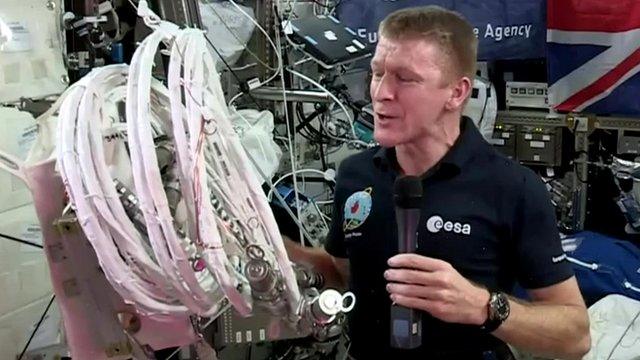Five things about Tim Peake's spacewalk
- Published

Five things you need to know about Friday's spacewalk:
1. It has to be carried out in darkness
The two astronauts are fixing an electrical box that regulates voltage from one of the station's solar arrays. It needs to be fixed to get the space station running back on full power.
The repair involves manoeuvring a spare box weighing 90kg (200lbs) out along the truss that spans out from the compartments where the astronauts live and work.
For safety reasons, it has to be done during darkness when the solar panels are not generating power from the Sun.
Royce Renfrew, ISS spacewalk flight director, explains: "We do it during the night pass - that way we're absolutely guaranteed that there's no power flowing through there, because there's no Sun to generate any electricity."
This gives the two Tims 31 minutes to complete the repairs. If they don't finish in one go, they must wait for darkness in the second or third orbit of the Earth to finish the re-fit.
The key task of the spacewalk is to fix the box. But there should be time for other tasks, including laying cables for new docking ports and reinstalling a valve that was removed last year.
2. Tim and Tim may need a toothbrush
The astronauts will work together to replace the faulty component. One crucial step is bolting the new box into position. Past experience has shown that the threads of bolt can get blocked with debris - which can be removed with a toothbrush.
Tim Peake talks about the suit he will wear for his spacewalk on Friday
3. Like all spacewalks, it will be a risky business
Working in the harsh environment of space is hazardous. Both astronauts have prepared for spacewalks in astronaut training but things can go wrong. If all goes to plan, Tim Peake will lay cables on the outside of the space station after fixing the faulty box. Tripping over a cable is one risk as is being hit by a small meteorite or getting a hole in your spacesuit. Spacesuits provide protection for the astronauts but their bulk can make it hard to carry out delicate tasks.
As Paul Dum, Nasa's lead spacewalk officer, puts it: "Spacewalking is challenging - you have to wear a spacesuit which is sort of your own independent space ship to protect you from the harshness of the environment.
"So there's a trade off between having as much protection as possible but still maintaining mobility.
"So imagine going out with thick winter gloves on and trying to do anything that takes fine dexterity. That's going to be challenging."
Like rock climbers, the astronauts must always be tethered to space station supports to prevent them floating away.
4. Spacewalks are far from routine but not that rare either
There have been 191 spacewalks for maintenance at the space station, including a similar walk completed in 2014 by US astronaut Reid Wiseman.

Michael Foale (L) became the first Briton to carry out a spacewalk on a US shuttle mission in 1995
The Nasa astronaut will help guide the current spacewalk from mission control in Houston.
The spacewalk will be the first for Tim Peake and the third for his Nasa colleague, Tim Kopra.
5. There's little time to enjoy the view
Tim Peake, writing on his blog, said he felt "exhilarated" by the prospect of walking in space, but had no time to dwell on these emotions.
British-born US astronaut Nicholas Patrick, a spacewalk veteran, said he should find time to enjoy the "majesty of the view" during his trip outside.
Dr Patrick told the BBC Radio 4 Today programme: "When you float out, it is a remarkable feeling.
"You are used to floating - by this point Tim has been in space for a month, he will know exactly what floating is like - what he won't be used to is being outside the space station with a fabulous view and, perhaps more importantly, with a very difficult set of time-critical tasks ahead of him.
"My bet is that, like me, when he goes out he won't be looking down initially, he will be looking left and right, finding his way around and getting ready for the tasks ahead.
"But it's a great thing to go out, it's really a wonderful experience."
Follow Helen on Twitter, external


Tim Peake in space: Want to know more?
Special report page: For the latest news, analysis and video
Guide:, external A day in the life of an astronaut
Explainer: The journey into space and back
Social media: Twitter looks ahead to lift-off

- Published15 January 2016
